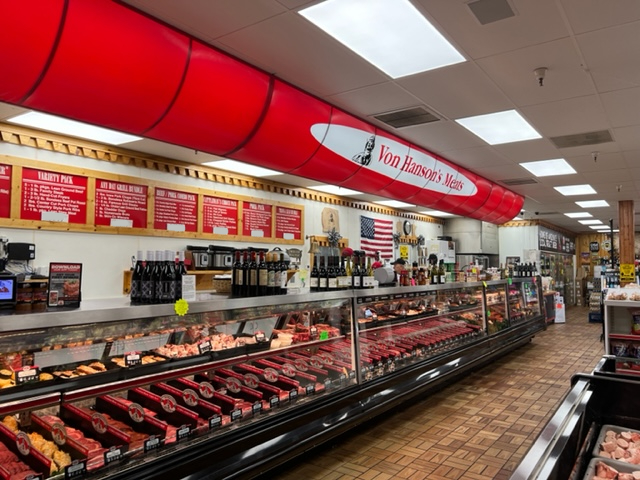Top Reasons to Patronize Bagley Farms Meat Market Edwardsville IL for Costs Meats
Top Reasons to Patronize Bagley Farms Meat Market Edwardsville IL for Costs Meats
Blog Article
Discover the Art of the Butcher's Cut in a Modern Meat Market
In the ever-evolving landscape of modern meat markets, the butcher's cut has actually transcended its standard origins, combining old-time workmanship with contemporary practices. What truly sets the contemporary butcher apart is their ability to create a much deeper connection between consumers and the beginnings of their meat.
Advancement of Butchery Strategies

The mid-20th century saw butchery methods further improved by scientific insights right into muscular tissue biology and meat aging, improving both tenderness and preference. Technologies like vacuum cleaner packaging and refrigeration expanded item shelf-life, enabling butchers to branch out offerings and enhance high quality control. This duration additionally marked the surge of customized devices, such as band saws and meat slicers, which boosted accuracy and performance in meat processing.
Electronic systems currently help in tracking pet provenance and enhancing cuts to fulfill certain client choices. Additionally, a rebirth in artisanal butchery has arised, mixing typical abilities with modern-day understanding to cater to customers seeking ethical and lasting meat alternatives.

Recognizing Meat Cuts

Comprehending the details of meat cuts is essential for both butchers and consumers seeking quality and value. For butchers, precise cuts reflect skill and respect for the craft, guaranteeing very little waste and ideal yield.
The key classifications of meat cuts consist of primitive, sub-primal, and retail cuts. Butchers then damage these down better into sub-primal cuts, before finally producing retail cuts available to customers, like ribeye or tenderloin.
Recognizing muscle mass structure is crucial; muscles used a lot more regularly by the animal tend to be harder and are best suited for slow cooking approaches, while less-used muscles, like those found in the loin, are more tender and ideal for barbecuing or roasting. Familiarity with these distinctions empowers customers to make educated options, improving their cooking undertakings.
Picking Quality Meat
Choosing the ideal meat entails even more than simply selecting a visually attractive piece from the display screen. The art of picking top quality meat requires a discerning eye and expertise of particular characteristics that indicate quality and excellence. Firstly, take notice of the shade; beef needs to have an intense, cherry-red shade, while lamb must display a soft pink tone, and pork a light pink. This suggests the meat is fresh and hasn't been revealed to oxygen for too long.
Second of all, consider the marbling, which refers to the white flecks of fat within the muscle mass. Proper marbling is a crucial sign of inflammation and flavor, as it thaws throughout food preparation, improving the meat's juiciness. Keep in mind, greater marbling commonly associates with superior high quality cuts, such as USDA Prime.
Appearance is one more critical aspect; meat must feel firm to the touch, not slimy or overly soft. Additionally, bear in mind the fragrance. Fresh meat needs to have a clean, neutral scent, free from go any type of sour or repulsive smells.
Coupling Cuts With Cooking Methods
Successfully pairing cuts of meat with the ideal food preparation approaches is vital for accomplishing optimum taste and appearance. These approaches enhance the meat's all-natural tastes and make certain a juicy finish.
On the other hand, harder cuts like brisket and chuck roast are abundant in collagen, which damages down right into gelatin when cooked slowly. These cuts are suitable for braising or sluggish roasting, enabling the meat to tenderize with time and develop deep, intricate flavors. Cuts such as brief ribs and pork shoulder make out well with slow-cooking techniques, where prolonged cooking times change their durable structures Read Full Article right into succulent recipes.
Lamb shanks and oxtail, which need prolonged cooking to tenderize, are excellent prospects for stewing or sluggish simmering. These methods coax out abundant, passionate flavors while maintaining moisture. By understanding the unique features of each cut, cooks and home chefs alike can boost their culinary creations, ensuring each recipe is both pleasing and unforgettable.
The Butcher's Duty Today
Navigating the progressing landscape of the modern meat market, the butcher's duty today expands past simple preparation of cuts. Contemporary butchers are culinary artisans, instructors, and supporters for sustainable techniques.
In enhancement to crafting precise cuts, butchers currently engage straight with customers, supplying cooking suggestions and tailoring choices to suit private requirements and choices. Their proficiency in meat aging, marbling, and flavor accounts empowers consumers to make enlightened decisions, boosting their cooking experiences. This personalized service exhibits the butcher's evolving role as a trusted advisor in the kitchen area.
Moreover, butchers are critical in lessening waste, using whole pets to develop varied items such as sausages and supplies - bagley farms meat market edwardsville il. This thorough method not just values the animal yet additionally straightens with contemporary sustainability objectives. By doing this, the contemporary butcher personifies both custom and development, adapting to an ever-changing market while protecting the creativity and honesty of their craft

Final Thought
The modern butcher's craft intricately weaves standard methods with modern technologies, emphasizing lasting methods and honest sourcing. Mastery in comprehending diverse meat cuts and top quality indicators equips butchers to provide enlightened recommendations, aligning certain cuts with ideal cooking methods. This know-how not just elevates culinary experiences advice but likewise enhances the connection between customers and the origins of their food. By recognizing historical practices while embracing modern demands, the butcher's function stays vital in today's advanced meat market.
Report this page